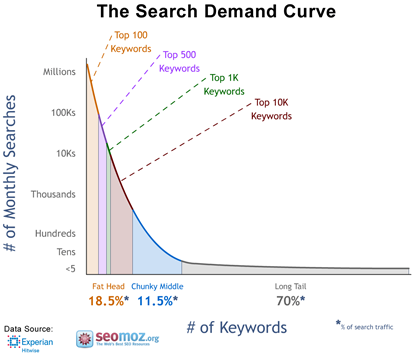
One of the most important fundamentals of an effective Search Engine Optimization strategy is the research, identification and use of keywords that are geared towards attracting targeted audiences towards conversion. Recent changes to the digital marketing world however, spurred by updates and changes to search engine algorithms, particularly Google’s Hummingbird, got many marketers and business into thinking – is keyword optimization still a viable process?
Such questions arose from the fact that algorithm changes are giving focus and more importance to conversational queries, particularly with the use of longer-tail keywords. In the past, most digital marketers avoid such keyword sets as these niche-based approaches to identifying keywords are usually branded by Google with the low or no search volume status. At face value, it seems using such types of keyword sets are not worth the effort.
But many are saying otherwise based from their experience, claiming that the use of low or no search volume keywords will be good for business. Such statements appear as the complete opposite of what traditional SEO practitioners believe in, but many claims this as true. For one thing, low volume keywords have lesser competition and thus easier to rank for, generate conversions and ultimately profit.
The following delves into the viability of use of low to no search volume for optimization to give marketers and business owners a deeper insight on whether such practices would be a worthwhile endeavor or not.
Low Search Volume Keywords
A particular keyword or keyword phrase is labeled as “low search volume” if it has generated minimal search traffic according to Google. In Google’s own definition, low search volume is “a status that’s given to a keyword with very little to no search history on Google.”
Because they are marked as having very little search history, Google will deem it irrelevant and will set the keyword to an inactive status so it won’t trigger your ads, particularly if you’re using these keywords for paid advertising. The problem with an inactive status is when someone types in an exact or matching phrase, your ads will not show up because of this seemingly negative label.
What Google recommends for such type of keywords is to change them altogether and remove it from your list, or you can opt to do nothing and wait for enough search volume to trigger the reactivation of this particular low search volume keyword. You’re left with the question of whether these keywords should stay – or should they go?
Search Volume or Conversions?

Source: Real Marketing Guy
Low search volume are usually associated with long-tail keyword phrases that have 3 or 4 more words which usually provide a more specific, localized or niche-based context. Unlike broad keywords that are usually listed by keyword planners and other research apps as having higher historical search volume, long-tail keywords very little traffic as seen from the Search Demand Curve shown above.
But even though such long-tail keywords have low search volume, the more specific and accurate nature of the phrase make it very relevant to targeted audiences, thus make it easier for them to convert. A great example is Amazon, generating as much as 57% of its sales because of long-tail keywords. Such facts could get one into questioning himself as to what would be more important for him – search volume or conversion.
Even if you have hundreds or thousands of traffic generated by broad keywords, it does not necessarily mean that you’ll also get a corresponding amount of conversions. In many cases, traffic that comes from a too-general a source may eventually come out as worthless. On the other hand, low search volume long-tail keywords caters to a specific set of audience that have more likelihood for conversion.
Rachel Sprung from Hubspot presents the following elements that you should consider more importantly than going for mere search volume. These include:
- Attracting people based on interests and needs – Your keywords and content should be relevant to what your actual targeted clients need or are interested in – those who would most likely become paying customers.
- Feasibility – Instead of focusing on search volume, you need to consider the possibility of ranking for the keywords you selected, and if you have the means to pull it off. Ranking means performing a series of SEO activities, creation of content, link building and social engagement – and this will require time and resources.
- User Experience – Traffic that bounces off because they don’t like what they find or experience in your site will do your SEO no good. On top of keyword research, you need to focus on how you can optimize your content and site to deliver the best user experience your site visitors they won’t get elsewhere.
- Buyer Persona – It does your business no good if you attract a lot of traffic that are really not interested in what you have to offer. To make sure this won’t happen to you, identify keywords and create content designed to cater for your targeted buyer persona.
Marketing to No Search Volume Keywords
Keywords reported by Google as “No Search Volume” does not actually mean it has practically zero search volume at all. It such cases, that particular keyword or keyword phrase has a very minimal monthly search volume that Google deemed it irrelevant. The question is – is it worthwhile to market to No Search Volume keywords?
According to Marketing Tech Blog, marketing to no search volume keywords have actually done good for one of their clients Right on Interactive. At the start of their campaign, they focused on using a relatively new phrase “customer lifecycle marketing” which practically had no search volume. The term however was very relevant to their brand and product so they persisted in using the term. Their efforts paid off as the term now generates more than 30 highly targeted searches each month – with them topping the ranking ladder of course.
The point here is that even though a particular keyword phrase has very little search volume but is highly relevant to your brand or product, it can actually be beneficial for your marketing efforts to continue using them. Even if it attracts only a few visitors each month, but you’re generating a very high percentage of leads, you can have higher chances of generating conversions and turning them into customers.
Keyword Research the Modern Way
In this new era of semantic search, the use of long-tail keywords that may have low or no search volume may be a viable technique that you can use for your campaign. The keyword selection process however is not a simple guessing game, even if you’re going for low search volume keywords.
The following describes specific considerations that you should take in order to perform and effective keyword research strategy in this modern age of semantic search.
1. Ideas-Based Approach – instead of solely relying on what keyword planners and other similar applications deliver, you need to be wiser and use an ideas-based approach to keyword research. Such planners only deliver closely-related search terms, so you might be missing out on highly targeted traffic from low search volume but highly relevant keywords they will be omitting.
The habits of search users vary widely across industries and demographics, so you need to be creative and try to identify which particular variation your targeted audiences will use. There are lots of sources that you can rely on to give ideas on possible keywords that may actually work. This ranges from search assists and auto-complete features of search engines, to actually looking at your competitors blogs and websites for ideas.
2. Relevant Words – You need to evaluate the words suggested by automated keyword research tools if they are actually relevant to your brand, products and services. On top of that, you also need to evaluate if the words suggested are relevant to humans as well – to ensure that these keyword selections will convert. You can get ideas for relevant words from the following, not-likely, sources:
- PPC historical data – If you have existing Pay-Per-Click campaigns, you can check out historical conversion data as possible references
- Non-SEO marketing people – These executives and professionals might have insights about potential keyword phrases that are effective for your campaign based on their experience from previous market research
- Sales/Customer Service People – These people in your organization deal a lot directly with customers and are familiar with the language and other jargon your targeted audiences might be using
- Competitors Blogs/Sites – It would be worth your while to take a quick look at your competitors’ blog pages and websites and try to harvest relevant keywords that they may be using
- Random People from Your Target Demographics – It pays to actually get in touch with actual people who fit or belong to your target demographics, and extract search words that they may be using
3. Keyword Stacking – This should not be confused with the traditional practice of “keyword stuffing”. Keyword stacking is actually making use of low search volume keywords and adding them to your main keyword sets in your content
4. Target Locally – As much as 43% of search queries at Google have a local intent. This means that you can actually get better traction with low search volume keywords by adding in local elements to your long tail phrases
5. Keyword Effectiveness and Difficulty – You can do away with focusing on search volume and make use of the Keyword Difficulty Score and the Keyword Effectiveness Index (KEI) to give you insight on how hard it will take you to rank for a particular keyword
So there you have it, the use of low and no search volume keywords can be worthwhile if you do your keyword research right. The effectiveness of keyword research does not rely solely on search volume but on how relevant a particular keyword set is for your brand, products and services. The higher the relevance of your chosen keywords – even if they register a low search volume – can attract highly targeted traffic that actually converts.
Jomer B. Gregorio is a well-rounded expert when it comes digital marketing. Jomer is also known as a semantic SEO evangelist and practitioner. Check out our Digital Marketing Services today and let us help you in achieving positive and profitable results for your business.
